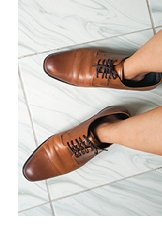Meaningful Connections Don't Start With
A Pat
On The Back,
But A Brief Walk In Someone Else's Shoes
Greetings *|FNAME|*,
 The human condition is frequently characterized as a journey down our own unique path. Each of our paths cross countless others during this lifespan, running parallel for a time as we quest for meaning together until the end of our days. The analogy of "walking a mile in someone else's shoes" is apt, because true connection comes through our deep understanding of one another. But the key obstacle to this understanding is fear, which we see manifest too often in the news, between political parties, or even among our faiths. Fear makes us go "tribal", where we only interact with those who are similar to us. This leads to systemic fragmentation, be it at work, at school, or simply in life. Ironically, the result of this fear-based approach makes everyone less, rather than more, safe.
The human condition is frequently characterized as a journey down our own unique path. Each of our paths cross countless others during this lifespan, running parallel for a time as we quest for meaning together until the end of our days. The analogy of "walking a mile in someone else's shoes" is apt, because true connection comes through our deep understanding of one another. But the key obstacle to this understanding is fear, which we see manifest too often in the news, between political parties, or even among our faiths. Fear makes us go "tribal", where we only interact with those who are similar to us. This leads to systemic fragmentation, be it at work, at school, or simply in life. Ironically, the result of this fear-based approach makes everyone less, rather than more, safe.
In fact, there are enormous benefits when a business helps facilitate a reduction of fear among its employees by building mutual understanding, tolerance, then empathy. However, it can be a challenge to know how to start that process. And it takes some personal investment and risk to authentically engage in this process.
Many years ago, I was working on the FSU Artist Series and we hosted the Vienna Boys' Choir for a Fall performance. At the time, my sons were the same age as the performers. When our team started talking about how to make them feel welcomed, it occurred to me the boys from Vienna were very far from their home, and might enjoy a fun night of pizza and movies. I was able to arrange for a patron to host the gathering after their performance, and we all had a great time getting to known each other. We made it safe for these young performers far from home to feel included and appreciated.
 During that leg of my life's journey, my greatest challenge as a single parent was for my family's financial stability. Each Christmas, my supervisor at the time, Sandy Jupin, gave staff members gifts of appreciation, recognition and encouragement. Although she was only partially aware of my personal difficulties, her gift to me was a round crystal ball that cast light patterns. It was intended to inspire hope for the possibilities of the future. And it was a surprise, affecting me profoundly and planting the seed of recognition deep inside me. Fast forward to the present, and this past Christmas I tried to emulate the same activity.
During that leg of my life's journey, my greatest challenge as a single parent was for my family's financial stability. Each Christmas, my supervisor at the time, Sandy Jupin, gave staff members gifts of appreciation, recognition and encouragement. Although she was only partially aware of my personal difficulties, her gift to me was a round crystal ball that cast light patterns. It was intended to inspire hope for the possibilities of the future. And it was a surprise, affecting me profoundly and planting the seed of recognition deep inside me. Fast forward to the present, and this past Christmas I tried to emulate the same activity.
Last year, Change by Design had a wildly successful year. But we did experience a few growing pains, especially for members of my core team who stretched to meet requirements of various client projects. Thankfully, we are stronger from these experiences and because of what we learned in the process. At the end of the year, I took some time to consider the important contributions each person in my core team made in 2021 toward Change by Design's success. I immersed myself indirectly into the areas and hobbies that interest them. Then I sought out gifts that would meet them where they were at. In each case, they were surprised, delighted, and inspired by the way I expressed my gratitude. These weren't cheap, generic gifts. They were items that each person appreciated, reflecting some basic understanding of who they are, what they like, and what is important to them. These gifts required me to stand in their shoes.
It might seem easier to just do the bare minimum, whatever that is. But a simple pat on the back doesn't make much of an impression, especially when it is devoid of contextual meaning. Realizing the benefits of a diverse company culture, like creativity, innovation and risk mitigation requires that we embrace people whose "shoes" and "path" may be very different than our own. But most of us are very cautious about being vulnerable, especially when someone seems fundamentally different than we are.
 So we have to begin with small steps first to build mutual trust. Recognizing and honoring different communication styles is a basic starting point. When people are heard, they are more willing to risk being vulnerable, especially when that risk pays off in larger ways. The best result is that when someone contributes, everyone hears it differently than they did before. That builds greater team cohesion, and reduces fear, because we do not view anyone in the group as a threat. There is a shared sense that everyone is watching each others' backs. And with trust, everyone is more open to different perspectives, leading to greater options on the table for us to consider and consolidate into a better, more comprehensive approach. This leads to higher quality services and/or products for our customers. In turn, we receive better testimonials and more frequent referrals by our clients to others who might need Change by Design's services but don't yet know who we are. Effectively embracing diversity is a win for everyone.
So we have to begin with small steps first to build mutual trust. Recognizing and honoring different communication styles is a basic starting point. When people are heard, they are more willing to risk being vulnerable, especially when that risk pays off in larger ways. The best result is that when someone contributes, everyone hears it differently than they did before. That builds greater team cohesion, and reduces fear, because we do not view anyone in the group as a threat. There is a shared sense that everyone is watching each others' backs. And with trust, everyone is more open to different perspectives, leading to greater options on the table for us to consider and consolidate into a better, more comprehensive approach. This leads to higher quality services and/or products for our customers. In turn, we receive better testimonials and more frequent referrals by our clients to others who might need Change by Design's services but don't yet know who we are. Effectively embracing diversity is a win for everyone.
Unexpected and considerate gift-giving is another way to build bridges to others. A meaningful surprise can touch your heart like few other things. During this leg of my life's journey, as I've been struggling to persevere through the health challenges of breast cancer, I've been humbled by the kaleidoscope of ways how people have shown up for me and my husband. Ordering barbeque dinners delivered and bringing by homemade chicken noodle soup to nourish us. Going grocery shopping when we are overwhelmed with treatments, and volunteering to drive us places (including MD Anderson in Houston) so that I can get the care I need. Reorganizing our kitchen for ease and efficiency. Deep-cleaning our home. Donating money, points, credits and time. My cup has runneth over in gratitude to everyone who has been there for me, and continues to encourage me through my illness.
I sometimes fall short of acknowledging, celebrating, and embracing people who are different than me. It's only natural, but I strive to do better and hope you will too. Whenever you have the chance, try to take a brief walk in someone else's shoes - in whatever way you can. This will help you gain a more intimate understanding of their challenges, and be an invaluable opportunity to connect on a human level that transcends whatever differences there may initially seem to be. It's an approach that yields benefits, no matter where it is applied. And I'd love to hear back on how it goes and how the experience impacts your perspective!
Faithfully,


Sue
Email | LinkedIn | V-Card